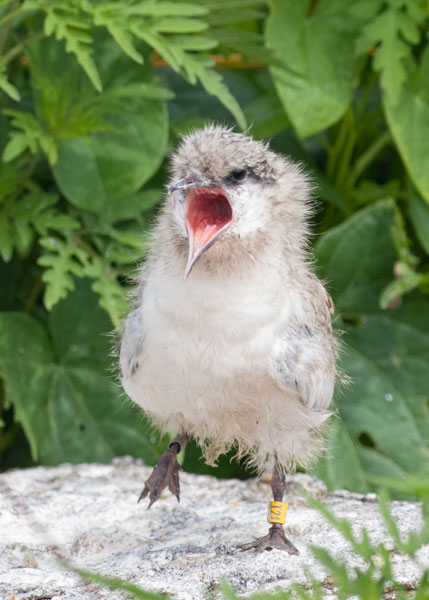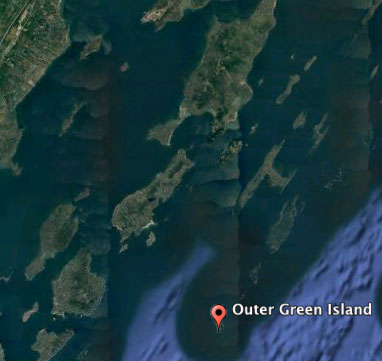
(click on photos to see full size)
SJ Kwiatkowska, Island Supervisor – National Audubon Society Seabird Restoration Program

(click on photos to see full size)
 Tern Census
Tern Census
The 2016 Gulf of Maine Seabird Working
Group (GOMSWG) tern census was conducted on Outer Green Island on 13 June. A
total of 1289 Common Tern (Sterna hirundo)
nests were counted. The inclusion of 41 productivity study nests (one clutch
was laid post census within the GOMSWG window), 24 feeding study nests, and a Lincoln
correction index of 1.01 (n=205) resulted in a corrected total of 1367 nests. This
is another new record for Outer Green Island, making it the largest tern colony
in Casco Bay, Maine for the second year in a row. There were no known Arctic
Tern (S. paradisaea) nests on the
island this year, but a single pair of three-year old Roseate Terns (S. dougallii) laid a single egg in grid
#10 on 26 June. This egg hatched on 20 July, and the chick was still alive and
well when researchers left the island on 1 August.
Table 1. GOMSWG
annual census on Outer Green Island, 2010-2016
Year
|
COTE
|
ROST
|
ARTE
|
2010
|
1151
|
15
|
0
|
2011
|
1067
|
0
|
0
|
2012
|
1034
|
0
|
0
|
2013
|
1143
|
0
|
0
|
2014
|
1139
|
0
|
0
|
2015
|
1353
|
0
|
0
|
2016
|
1367
|
0*
|
0
|
*One ROST nest was laid after 20 June
Tern Productivity
The first Common Tern egg was laid on
20 May. The average number of eggs per nest was 2.40 (n=65). The first hatch
was on 12 June, and peak hatch lasted approximately from 18-26 June. The average
number of eggs hatched per nest was 2.12, and the average number of chicks
fledged per nest (productivity) was 1.26.
Table 2. Outer Green
Island annual Common Tern productivity, 2010-2016
Year
|
Mean Clutch
|
Mean Hatch
|
Productivity
|
2010
|
2.81
|
2.63
|
2.09
|
2011
|
2.43
|
1.98
|
1.77
|
2012
|
2.81
|
2.19
|
1.42
|
2013
|
2.60
|
2.27
|
1.15
|
2014
|
2.13
|
1.92
|
1.42
|
2015
|
2.03
|
1.83
|
1.36
|
2016
|
2.40
|
2.12
|
1.26
|
Tern Provisioning
Chick provisioning was observed at 23
Common Tern nests (one nest never hatched) this season over 912 nest hours. A
total of 1199 feedings to chicks were recorded for an average feeding rate of 1.31
items per hour, which is lower than the 2014 feeding rate of 1.73 items per hour,
but higher than the 2015 rate of 0.97 items per hour. The most frequently
observed prey item was herring species (Clupeidae
sp.), which made up 35% of the observed diet. Hake species (Urophycis sp.) was the second most
frequently observed prey item, at 26% of the observed diet.
Predation
Early and late in the season, Ruddy
Turnstones (Arenaria interpres) were opportunistically depredating eggs.
Two
Black-crowned Night Herons (Nycticorax
nycticorax) landed and depredated at least two nests, a Peregrine Falcon (Falco peregrinus) predated one or two fledgling terns, and a Bald Eagle (Haliaeetus leucocephalus) landed on the
island twice. An American Mink was located and
subsequently shot on the island on 16 June 2016 after predating one adult Black
Guillemot (Cepphus grylle) in its
burrow. Throughout the season, Great Black-Backed Gulls (Larus marinus) and a few Herring Gulls (Larus argentatus) hunted at all times of day in the colony, but
increased their predatory activity at dawn and dusk and during poor weather
conditions. Deterrence methods included gull walks and lethal control. Two
Great Black-Backed Gulls (one adult, one juvenile) were shot. On neighboring
Junk of Pork Island, one Great Black-Backed Gull and two Herring Gull nests
were destroyed. On Outer Green Island, one Herring Gull nest was destroyed. One
Herring Gull was seen with a Common Eider (Somateria
mollissima) duckling, and an estimate of 3-10 young terns were predated
daily by large gulls during the peak predation period (18 June – 10 July).
Weather
The average, high, and low air
temperatures and average sea surface temperature (SST) this year are similar to
the island averages over the past 15 years. Air temperatures ranged from 42°F
to 85°F, with an average temperature of 61.5°F. Sea surface temperatures (SST) ranged
from 43°F to 67°F, with an average SST of 55.5°F. Precipitation was recorded on 24 days this season for a
season minimum of 9.9 inches (rainfall was not collected
in May).
Black Guillemots
This year, one new Black Guillemot burrow was found, raising the island total to 23 burrows. This year, 16 burrows were active, and 10 were followed for growth. Of the 16 active burrows, one burrow had what is considered a supernormal clutch of three eggs. This is the second year in a row of a supernormal clutch size on Outer Green Island. The burrow with three eggs had two eggs for a long period which felt cold, and then a third was found laid in the burrow. None of the eggs hatched, likely due to the disturbance from the American Mink during incubation. Because of the supernormal clutch, the average clutch size was 2.06, the average number of eggs hatched per nest was 1.25, and the estimated productivity (based on healthy chick growth at time of staff departure) was 1.13.
HELP KEEP INTERNS ON OUTER GREEN ISLAND
You can see the island from parts of Chebeague!
If you would like to help please contact Steve Kress at Audubon.
